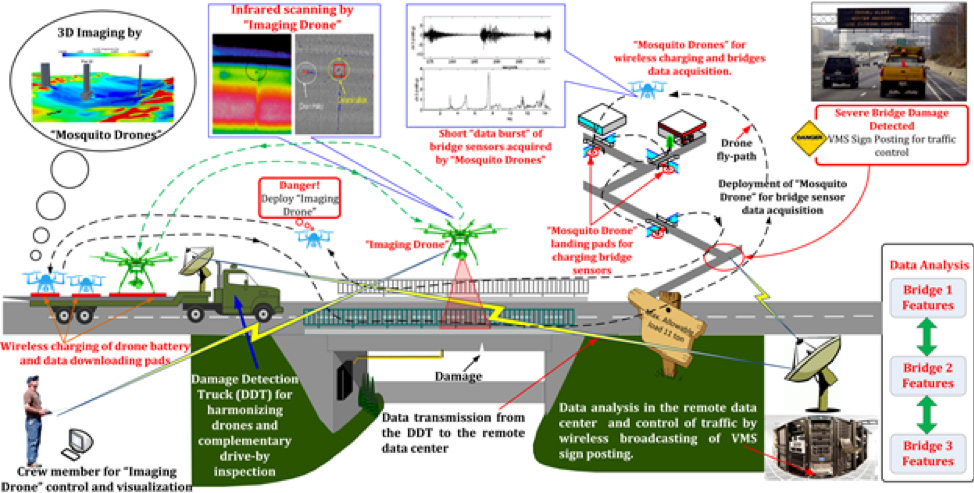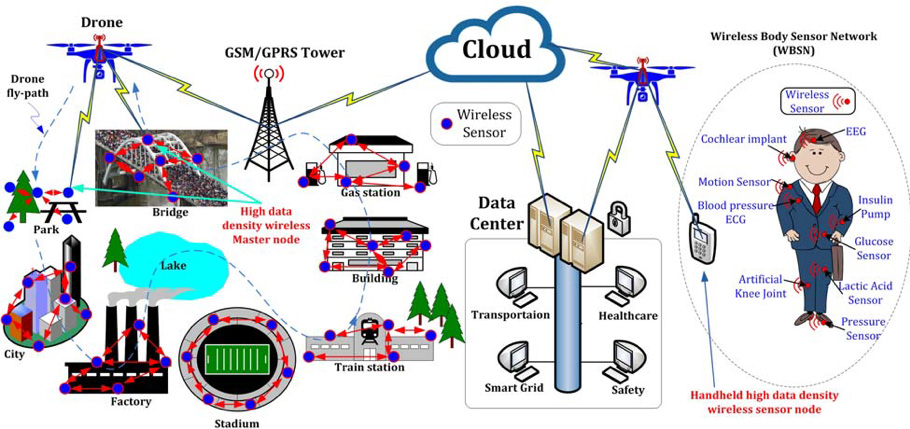Structural Engineering
The field of structural engineering deals with the design of buildings, bridges, and other structures with the goal of producing economic and efficient designs while maintaining the safety of the public. Structural engineering faculty at UAB have expertise in buildings, bridges, utility structures, structural health monitoring, and emerging materials.
Mobile Automated Rovers Fly-By (MARS-FLY) for Bridge Inspection and Resiliency
 Select image to see a larger version. Routine bridge inspections are an important but costly task. Bridges are often in remote locations and the cost of installing electricity and data acquisition systems on the hundreds of thousands of bridges in the U.S. is prohibitive. The MARS-FLY project is developing a cyber-physical system (CPS) designed to monitor the health of highway bridges, control the loads imposed on bridges by heavy trucks, and provide visual inspectors with quantitative information for data-driven bridge health assessment requiring no electricity and a minimum of data acquisition electronics on site. For fly-by monitoring, GPS-controlled auto-piloted drones will periodically carry data acquisition electronics to the bridge and download the data from the sensors at a close range. Larger Imaging drones carrying infrared (IR) cameras will be used to detect detail damage like concrete delamination. This research is funded by the National Science Foundation (NSF).
Select image to see a larger version. Routine bridge inspections are an important but costly task. Bridges are often in remote locations and the cost of installing electricity and data acquisition systems on the hundreds of thousands of bridges in the U.S. is prohibitive. The MARS-FLY project is developing a cyber-physical system (CPS) designed to monitor the health of highway bridges, control the loads imposed on bridges by heavy trucks, and provide visual inspectors with quantitative information for data-driven bridge health assessment requiring no electricity and a minimum of data acquisition electronics on site. For fly-by monitoring, GPS-controlled auto-piloted drones will periodically carry data acquisition electronics to the bridge and download the data from the sensors at a close range. Larger Imaging drones carrying infrared (IR) cameras will be used to detect detail damage like concrete delamination. This research is funded by the National Science Foundation (NSF).
For more information contact Nasim Uddin,
High Data Density Short Range Wireless Telemetry for the Next Generation Internet of Things (IoT)
 Select image to see a larger version. The proliferation of wireless sensors has enabled widespread deployment of multi-sensor networks for IoT applications. The cumulative data volume from these large groups of sensors is creating a bottleneck for real-time data transmission through the limited wireless spectrum. This project is investigating a two-phase approach to alleviate this problem. In the first phase, the project is investigating a local processing or computational unit for in-situ low-level signal processing and data reduction to enable high volume data communication within a specified bandwidth. In the second phase, the project is investigating a novel pulse encoding scheme using orthogonal pulses to compress the data volume even further. This two-fold data reduction (local processing and pulse encoding) will enable high data-rate support within the specified bandwidth. The proposed large-volume wireless data acquisition system can support multiple sensor-related applications such as transportation, public health, cortical mapping, and smart homes. This research is funded by the National Science Foundation (NSF).
Select image to see a larger version. The proliferation of wireless sensors has enabled widespread deployment of multi-sensor networks for IoT applications. The cumulative data volume from these large groups of sensors is creating a bottleneck for real-time data transmission through the limited wireless spectrum. This project is investigating a two-phase approach to alleviate this problem. In the first phase, the project is investigating a local processing or computational unit for in-situ low-level signal processing and data reduction to enable high volume data communication within a specified bandwidth. In the second phase, the project is investigating a novel pulse encoding scheme using orthogonal pulses to compress the data volume even further. This two-fold data reduction (local processing and pulse encoding) will enable high data-rate support within the specified bandwidth. The proposed large-volume wireless data acquisition system can support multiple sensor-related applications such as transportation, public health, cortical mapping, and smart homes. This research is funded by the National Science Foundation (NSF).
For more information contact Nasim Uddin,